Hasenpfeffer
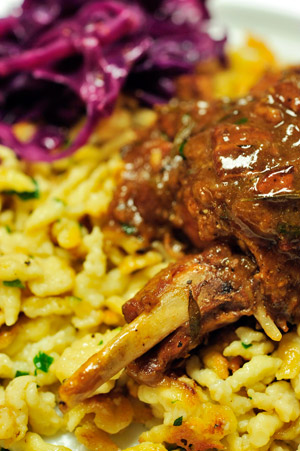 As the leaves change with the season, so does our appetite. With shorter days, colder nights, and wetter elements, we crave that soul-soothing comfort food. Sunday Suppers and hearty meals designed to not only stick to our bones and provide energy but to fulfill a deeper craving for nostalgia. German Beer Cuisine can satisfy these yearnings with slow-braised meats, crispy mini-dumplings, ales, and lagers. These slow-cooked foods allow us time to sip beer with our friends as we wait patiently for sinuous tissues to break down into tender bits of meat, filling the home with glorious aromas. Enter the German classic dish called Hasenpfeffer.
As the leaves change with the season, so does our appetite. With shorter days, colder nights, and wetter elements, we crave that soul-soothing comfort food. Sunday Suppers and hearty meals designed to not only stick to our bones and provide energy but to fulfill a deeper craving for nostalgia. German Beer Cuisine can satisfy these yearnings with slow-braised meats, crispy mini-dumplings, ales, and lagers. These slow-cooked foods allow us time to sip beer with our friends as we wait patiently for sinuous tissues to break down into tender bits of meat, filling the home with glorious aromas. Enter the German classic dish called Hasenpfeffer.
Hasenpfeffer is a German rabbit fricassee. This version of the traditional dish brings out the light clove and touch of caramel flavor from the German dark wheat beer style Dunkel Weisse, accented with smoked bacon and fresh herbs. It’s essentially a beer-braised rabbit stew. This recipe has origins in Bavaria or southern Germany, which borders the Czech Republic, Austria, Switzerland, France, and Luxembourg. The culinary history of this area blends across country borders. Routinely this rabbit stew is made with wine and vinegar. These flavors combine with peppercorns, rosemary, clove, sage, thyme, bay leaf, onions, and garlic, creating a delicious rabbit stew. Cooking with beer, in this case, uses the Germanic beer style Dunkel Weisse, changes the white wine characteristics that would traditionally influence the recipe, and rounds out these herbaceous notes while highlighting the Weizen yeast aromas and flavors. The phenolic (clove) and fruity (banana, bubble gum) character found in this beer style compliment all the recipes ingredients, making a truly special and delicious hearty, and soul-satisfying comfort food dish.
Most butcher shops will order a rabbit for you if ask ahead of time. Serve this Hasenpfeffer over a bed of Spatzle | Spaetzle, along with some braised red cabbage and pour a cold German Hefeweizen | Bock | Weizenbock | Gose to create a wonderful beer pairing with this meal.
Serves: 4 – 6 guests as an entrée
More German Beer Cuisine Recipes:
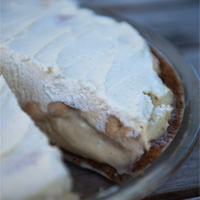
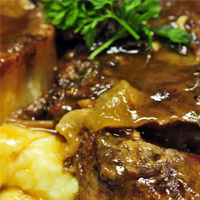
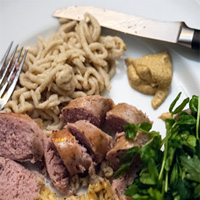
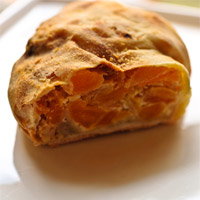
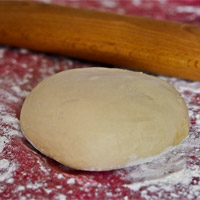



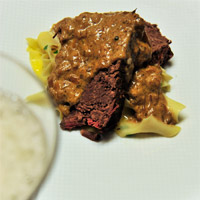

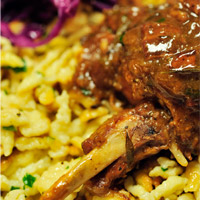




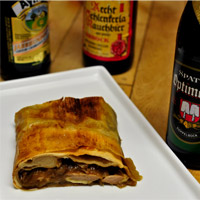





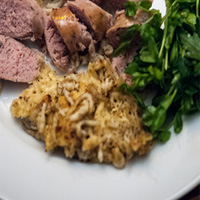

Adapted from BeerAdvocate Magazine: Cuisine à la Bière | Oct 2008 | Issue #21
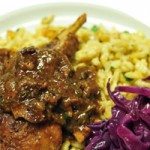
| Servings | Prep Time |
| 6 guests | 25 minute |
| Cook Time |
| 2 hour |
|
|

|
Hasenpfeffer is a German rabbit fricassee. This version of the traditional dish brings out the light clove and touch of caramel flavor from the German dark wheat beer style, accented with smoked bacon and fresh herbs.
|
- 1/2 pound bacon, smoked, thick cut, chopped into 1/2 inch pieces
- 4 - 5 pound rabbit, fresh, cut into six pieces (2 legs, 2 hind quarters, 2 breast | rib)
- 2 teaspoon salt, kosher
- 1 teaspoon peppercorns, black, freshly cracked
- 1/2 cup flour, all-purpose
- 1 cup shallots peeled and diced
- 2 tablespoon thyme leaves, fresh
- 1 tablespoon rosemary, leaves, fresh
- 1 tablespoon savory, leaves, fresh
- 10 each peppercorns, black, cracked
- 2 each bay leaves preferably fresh
- 2 each garlic, cloves peeled and minced
- 2 each cloves, whole
- 22 ounce Dunkel Weisse, such as Dunkelweizen
- 2 cup stock, chicken, or vegetable stock
- 2 teaspoon lemon juice
- 2 tablespoon flour, all-purpose
- 1 tablespoon parsley, Italian leaf leaves only,
- 1/2 teaspoon salt, kosher
- In a large Dutch oven over medium heat, add the cut bacon. Stir somewhat frequently to help the bacon cook evenly and to help render out the fat. Once the bacon is lightly crisp, but not burnt, remove it from the pot. Leave behind as much grease in the pot as possible.
- While the bacon is rendering, cut up the rabbit and season with the salt and pepper to coat. Using your hands, rub the seasoning into all over the rabbit pieces. Next, dredge each piece of meat in the flour, coating evenly on all sides, and place it into the pan with the drippings. Add enough pieces to cover the bottom, not letting the pieces touch. Cook for 6 – 7 minutes on each side to form a nice golden brown crust and set aside on a clean plate. Repeat the process until all the meat is cooked.
- If the bottom of the pan starts to have lots of burnt flour bits, the heat is too high. Clean the pan before continuing with the dish.
- Preheat the oven to 300°F | 149°C.
- Add the shallots, stirring to coat evenly in the remaining drippings, cooking for 7 -9 minutes to caramelize them. Add the thyme, rosemary, savory, peppercorns, garlic, and cloves, stirring to incorporate, and cook for 2 minutes to soften the garlic a touch. Season with salt and pepper. Deglaze the pot with the Dunkelweizen, scraping the bottom of any browned bits.
- Add the stock, along with the browned rabbit into the pot, bringing the mixture to a gentle simmer. Cover the Dutch oven with a tight-fitting lid and place it in the center of the preheated oven. Beer Braise for about 2 hours, depending on how accurate the oven temperature is. The rabbit should be fork-tender, but not completely falling off the bone. Remove the pot from the oven and place onto a burner, over medium heat. Carefully remove the rabbit pieces to a plate. If there is not very much braising liquid left, add more beer or stock to the pot. Add lemon juice (to add a touch of acidity to the sauce) and sprinkle in the flour and parsley. Using a whisk, stir as the liquid comes to a boil. The sauce will thicken as it cooks for 1 – 2 minutes, cooking out the starchy taste of the flour. The sauce should be the consistency of gravy. Add more beer | stock if too thick or flour if to thin, to adjust the consistency. Taste and season with salt and pepper if needed.
- To serve, place a piece of rabbit atop either Hefeweizen Spätzle, Pumpkin DBA Spätzle, Pretzel Spätzle or mashed potatoes infused with Bock. Sauce the beer-braised rabbit meat with its braising liquid gravy, garnishing with more chopped parsley and serve with braised red cabbage.
Hasenpfeffer Recipe Variations:
Chicken or duck can be substituted for the rabbit, if unavailable.



